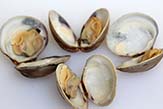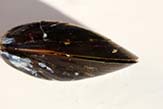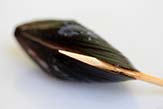Meats and Sausages
Clams
Shellfish RecipesClams, Protein-14.67%, Fat-0.96%, Water-78.98%
There is a great variety of clams that find the way to to the dinner table. Some, like beautiful Coquina (Donax) clams in West Florida are very small and are suitable for clam chowder soup only, others like Sand Clam (Spisula solidissima raveneli), Sunray Clam (Macrocallista nimbosa) or Quahog Clam (Mercenaria campachiensis) can be cooked or smoked.
The clams are abundant in most areas of the world. The Pacific razor clam (Siliqua patula) is an exceptionally meaty shellfish which ranges from California to Alaska.
Cleaning clams
Make a weak brine solution (10°) – 1/3 cup of non-iodized salt (iodine will kill clams) to one gallon (3.8 liters) of water. Soak clams in the brine for 20 minutes. Pour the clams into a strainer, and rinse with cold water. Scrub thoroughly with a stiff brush. Place clams on the towel and rub them dry to remove any final grit.
Place cleaned clams into a double pot steamer or a large kettle. Add half a cup of water for every pound (453 g) of clams. Cover the kettle and apply high heat. Steam the clams until they open their shells.
Depending on the type of clams, this may take from 3 to 10 minutes. Remove the open clams and serve. Discard any unopened clams as they probably were already dead.
Shucking
Many people enjoy eating raw clams and oysters. If you are shucking your own, the shells will be easier to open if you freeze them for 10 to 15 minutes or place them in refrigerator for 20-30 minutes. Remove them from freezer and let sit a few minutes before further processing. As they warm up, the muscles relax and the shells will open slightly so you can get your clam knife in. You have to, however, be fast as the moment you pick them up they will start closing up.
Insert the knife on either side and using the point cut as close to the shell as possible. This will detach the muscle from the shell. Now, the shell can be open with the fingers. Perform this operation over a bowl to save all that wonderful juice known as clam liquor.
Smoking Clams
- Clean the clams.
- Steam the clams until they open.
- Brine for 3-5 minutes in 40° brine. (Add 1.0 lb of salt to 1 gallon of water. This makes 40 degrees brine).
- Drain and pat dry. Dip in oil. Drain.
- Preheat smokehouse to 100° F (38° C) and dry the clams without smoke for 30 minutes.
- Increase temperature to 180° F (82° C) and apply a heavy smoke for 30 minutes.




















